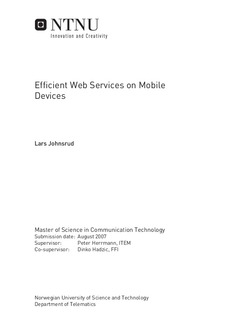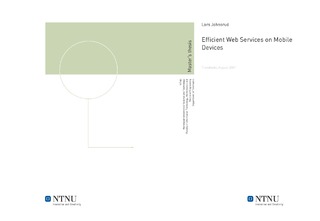| dc.description.abstract | Efficient solutions for Web Services on mobile devices would allow truly global, platform independent and interoperable information access, anywhere and at any time. While Web Services are continuously gaining ground, they are commonly reserved for use on personal computers and high-capacity servers, even though mobile devices are continuously becoming more advanced in terms of processing resources and wireless communication capabilities. This thesis identifies several challenges of accessing Web Services from mobile devices, and evaluates and discusses methods for creating more efficient solutions. Some of the challenges are the limited bandwidth and high communication latency. Reducing the size of XML information transferred and optimizing the communication protocol stack are identified as possible solutions to overcome these challenges. Additionally, as the communication cost correlates with the amount of data transferred, more efficient Web Services solutions are clearly beneficial for the end-user. The approaches described to reduce the size of XML files are traditional compression, alternative representation of the files, and binary XML. Binary XML is a compact representation of information that keeps the desirable structure of XML intact. The Efficient XML Interchange format currently being standardized by W3C is studied in more detail. Furthermore, optimizing the protocol stack has also been evaluated. A prototype Web Service system has been developed and tested in both simulated environments and in real surroundings using GPRS, EDGE and UMTS network connections. The results from the measurements show that both compression and the use of binary XML reduce the size of the information significantly and thereby the cost. Time needed to transfer the information is also reduced, and this effect is most apparent when the original files are large. Binary XML may however be the desirable format since it enables direct interaction with the information and keeps the memory footprint small. To reduce the time needed to transfer the information further, removing the HTTP protocol and optimizing the transport protocol, seems to minimize the effect of the latency. | nb_NO |

